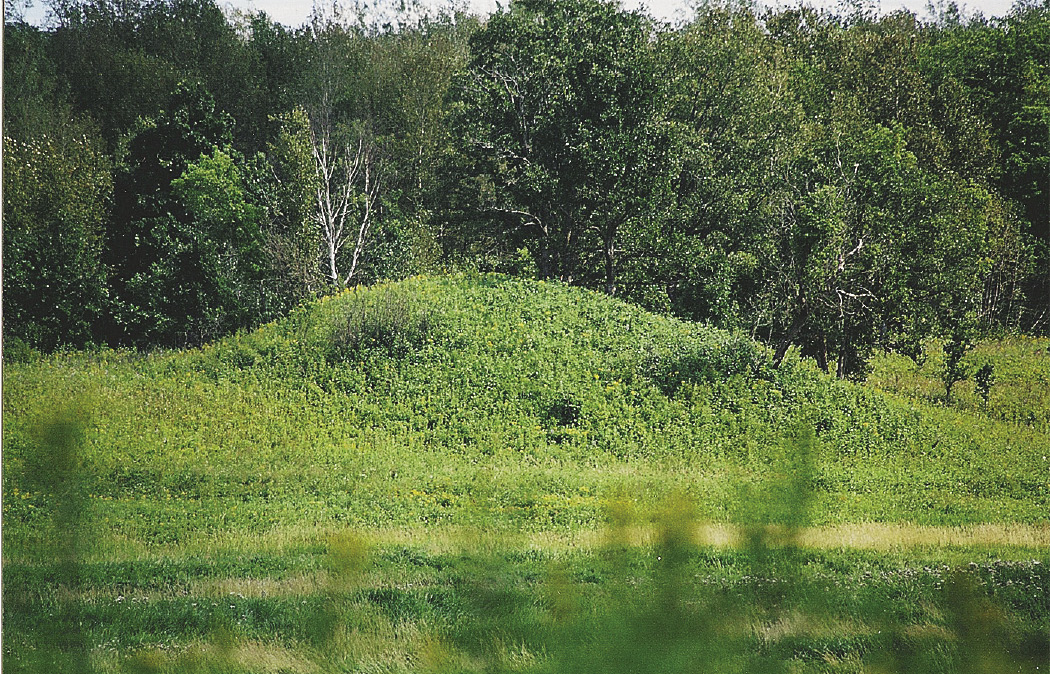There is something surreal and spiritual about being in a sacred place where the past connects with the present. And some of the most dramatic of those historic places are at ancient sacred mounds found in the Northern Wilds of Minnesota and Northwestern Ontario.
A chain of mounds runs along the Rainy River on both the Canadian-U.S. shores for 90 miles. They include Ontario’s famous Manitou Mounds, considered to be Canada’s largest pre-European structures.
Part of that chain are the five mounds at the Grand Mound Historical Site located at the juncture of the Big Fork and Rainy Rivers, about 20 miles west of International Falls. At the centre of the site is the Grand Mound, considered to be the largest surviving prehistoric structure in Minnesota and the upper Midwest, dating back to 200 BC (about the same time the Great Wall of China was completed). Believed to have been built by the Laurel people who predominated in the area until 100 A.D., the Grand Mound measures 140 feet long, 100 feet wide, 25 feet high and has a 200-foot low tail. Though the site has been permanently closed to the public since 2007, it is still preserved, owned, administered and maintained by the Minnesota Historical Society (MHS operated a visitor center here between 1975-2003).
On the Canadian side of Rainy River about 34 miles west of Fort Frances and International Falls is the Kay-Nah-Chi-Wan-Nung (Ojibway for Place of the Long Rapids), with a history dating back 8,000-9,500 years. The place was already at the centre of a vibrant North America-wide trading network, as far back as 5,000-6,000 years. Today, it is best-known for its 23 ancient burial mounds—the largest concentration of mounds in Canada–and village sites built on river terraces edging the Rainy River and Long Sault Rapids. Called the Manitou Mounds, the first ones were built about 2,500 years ago, and the area has now been declared a National Historical Site. The guardians of this rich heritage are the Rainy River First Nations who have built a historical centre on the 90-hectare site that encompasses more than three kilometres of the shoreline.
Walking among these ancient beehive-shaped mounds (only some are accessible to the public), I could feel the powerful presence of history. The mounds, varying in size, are located in a beautiful setting of river terraces edging the Rainy River, surrounded by prairie oak savannah. The sense of history was particularly strong while standing beside the mound that had inspired W. A. Kenyon to write, “The most spectacular prehistoric native monument in all of Canada is a burial mound on Rainy River. Overlooking the long Sault Rapids, it is about 113 feet in diameter and 24 feet high.”
Standing and absorbing the scenery, one could almost hear the sounds of these ancient people as they gathered here and along the Rainy River each summer by the thousands. They fished with spears and hooks for lake sturgeon that could weigh up to 400 pounds and reach 13 feet in length. They planted summer gardens, leaving a rich diversity of plant life in a prairie oak savannah. And they traded, bringing in items like marine shells from Florida, volcanic glass from Mt. St. Helen’s in Washington State, stone from Hudson Bay, obsidian from Wyoming, flint from the Dakotas.
The mounds here were constructed by digging a shallow pit, placing in the bones (either bundled in birchbark or hides) and covering the remains with earth. The following year, the burial ceremony would be continued until, as more individuals were buried and more earth placed on top, the mounds grew in size to what we see today. Mounds elsewhere have contained grave offerings like shells, copper ornaments, and, in some cases, clay funerary masks.
Notable earthworks further south in Minnesota include the six Hopewellian burial mounds featured in Indian Mounds Park, a public park overlooking the Mississippi River in St. Paul. Originally, there were more than 30 mounds, but most were destroyed in the 19th century. The first mounds were built 2,200 years ago by people of the Hopewell culture, who had arrived in the upper Midwest from Illinois circa 500 BC and stayed for about 1,000 years before they disappeared; later the site was used by the Dakota for burials.
In case you wondered, the largest man-made earthen mound north of Mexico is Monks Mound at the 2,200-acre Cahokia Mounds State Historic Site on the Mississippi River in southern Illinois. The four-terrace platform mound is 1,000 feet long, 800 feet wide, and was built between 900-1,200 AD using an estimated 22 million cubic feet of earth. In the 1200s, Cahokia was among the world’s largest cities with a population of 100,000.
This story was originally published in the April 2014 issue of Northern Wilds magazine.




